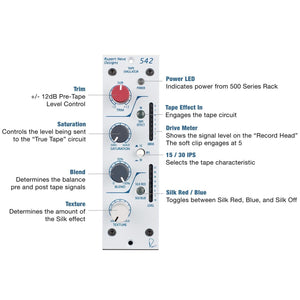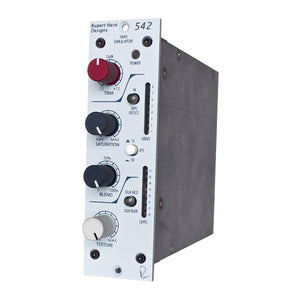Your Cart is Empty



$1,498.00
RUP-542
Rupert Neve Designs 542 - 500 Series Tape Emulator
The Rupert Neve Designs 542 is a 500 series module designed to emulate the tonal character of analog tape. The tape circuit found in the 542 is a specially designed transformer that acts as a record head - the more voltage sent into it creates saturation that engages a soft-limit circuit to soften the transients. Described as the “colour box” the 542 highlights 3rd order harmonics, and its soft/clip circuit softens harsh sound sources and enhance 2nd order harmonics.
Type: 500 Series
-
-
Rupert Neve Designs 542 Features:
Unlike digital emulations, the “True Tape” drive circuit works by feeding a custom-designed transformer acting as a “record head”, which in turn is coupled to a correctly equalized replay amplifier. As the voltage rises on the “record head”, saturation increases, and a soft clip circuit engages at higher levels to round off peak transients. The sound of the tape circuit can be further modified with selectable 15 / 30 IPS modes and a pre/post-tape blend control. In addition to the tape circuit, the 542 also has the variable Silk & Texture circuitry found in the Portico II series of modules, which allows the engineer to fine-tune the harmonic ratio and tonality on the output transformer.
Getting the Most Out of the 542
While in the olden days, tape’s non-linearity was generally looked upon as more of a curse than a “feature”, the advent of digital systems that operate in a completely linear fashion has made many appreciate the quirks of non-linear audio processing. Unlike linear designs, non-linear devices require the user to actively experiment with gain staging to find the “sweet spot” of the circuit. Although this requires a small amount of effort on part of the engineer, if used properly, the effect can add a dynamic aspect to performances that can enhance the impact of a song. -
Rupert Neve Designs 542 Specifications:
Line Amp Specifications (Measurements with tape circuit disengaged)
Noise:
Measured at Main Output, un-weighted, 20Hz-22kHz, Input Terminated 40 Ohms.
Unity Gain Better than -100dBu
Frequency Response
Measured at +10dBu, trim at unity.
Main Output +/- 0.25dB from 5Hz to 60Khz
-2dB @ 120KHz
Maximum Output Level 23.25dBu
Total Harmonic Distortion and Noise:
@ 1kHz, +20dBu output level Better than 0.0025%
@ 20Hz, +20dBu output level 0.07% Typical (2nd and 3rd harmonic)
Tape FX Specifications
Noise:
Measured at Main Output, un-weighted, 20Hz-22kHz, Input Terminated 40 Ohms.
Saturation @ minimum Better than -100dBu
Saturation @ maximum Better than -100dBu
Frequency Response:
15 IPS, Input @ -0 dBu -3dBu @ 28kHz
Saturation @ minimum 0dBu @ 10Hz
+5dBu Peak @ 60Hz
Saturation @ maximum -3dBu @ 20kHz
-3dBu @ 12.5Hz
+2.4dBu Peak @ 60Hz
30 IPS, Input @ -0 dBu -3dBu @ 120kHz
Saturation @ minimum -3dBu @ 10Hz +3.15dBu Peak @ 125Hz
Saturation @ maximum -3dBu @ 100kHz
-3dBu @ 12.5Hz
+1.3dBu Peak @ 110Hz
Total Harmonic Distortion and Noise
Refer to sweeps on page10
15 IPS, Input @ -0 dBu 0.4% @ 3kHz to 1% @ 175Hz typical
Saturation @ minimum Greater than 1% below 175Hz typical
Saturation @ maximum 1% at 6kHz typical
0.3% @ 1kHz to 3% @ 50Hz typical
30 IPS, Input @ -0 dBu 1% at 1kHz typical
Saturation @ minimum 0.6% @ 400Hz 5% @ 20Hz typical
Saturation @ maximum 1.5% @ 20kHz to 0.4% @ 1kHz typical
0.4% @ 1kHz to 2 %@ 50Hz typical
Power requirements:
Supplied by 500 series rack with 110-125 mA @ +/- 16V DC
Requires 500 series rack / power supply to operate. Sold separately.



